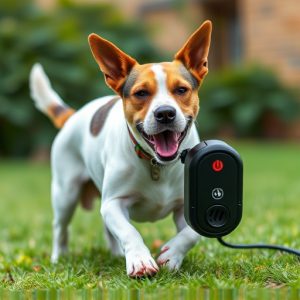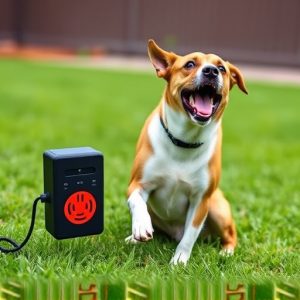Safe Dog Training: Exploring Ultrasonic Frequencies and Their Benefits
Ultrasonic technologies offer a safe and effective method for dog training, leveraging inaudible (to…….
Ultrasonic technologies offer a safe and effective method for dog training, leveraging inaudible (to humans) sound waves between 23-64 kHz to modify behavior. These devices emit high-frequency tones that dogs can sense, providing a mild corrective stimulus without causing harm or hearing damage. Validated by research, ultrasonic pet training devices are preferred over traditional, potentially abusive methods, ensuring pet safety while encouraging positive behavioral changes through consistent, short sessions of targeted sound activation and reinforcement.
Discover the revolutionary power of ultrasonic pet training devices, a safe and effective approach to canine discipline. This article delves into the science behind these innovative tools, explaining how they utilize specific ultrasonic frequencies to guide your dog without harm. Learn about their numerous benefits, from promoting good behavior to ensuring your peace of mind. We’ll also explore safety measures, usage tips, and training strategies for responsible pet ownership.
- Understanding Ultrasonic Technologies for Pet Training
- The Science Behind Safe Ultrasonic Frequencies
- Benefits of Using an Ultrasonic Dog Control Device
- Ensuring Safety and Mitigating Risks
- Effective Usage and Training Tips for Pet Owners
Understanding Ultrasonic Technologies for Pet Training
Ultrasonic technologies have emerged as innovative tools in pet training, offering a safe and effective approach to behavior modification. These devices emit high-frequency sound waves that are inaudible to humans but can be sensed by dogs. Understanding how ultrasonic frequencies interact with canine hearing is key to their effectiveness and safety.
The specific safe ultrasonic frequencies for dog control typically range from 23 to 64 kHz, well above the human hearing range of 20 Hz to 20 kHz. This technology leverages a dog’s sensitivity to high-frequency sounds, which can be used to deliver a mild, yet effective, corrective stimulus when they display unwanted behavior. By emitting these ultrasonic tones, dogs learn to associate certain actions with an unpleasant but non-harmful sensation, encouraging them to modify their behavior over time.
The Science Behind Safe Ultrasonic Frequencies
The Science Behind Safe Ultrasonic Frequencies for Dog Control
Ultrasonic pet training devices operate on the principle of emitting high-frequency sound waves that are inaudible to humans but can be detected by dogs. These devices utilize safe ultrasonic frequencies, typically ranging from 22 to 64 kHz, which are well above the human hearing range (typically 20 Hz to 20 kHz). This technology leverages a dog’s sensitive auditory system, which is more receptive to higher frequencies. When a dog approaches a certain trigger area, the device emits these ultrasonic signals, creating an unpleasant but harmless sensation that discourages unwanted behaviors.
Safe ultrasonic frequencies for dog control have been extensively studied and found to be non-harmful. They do not cause physical pain or hearing damage to dogs. Instead, they use sound pressure levels tailored to be annoying enough to deter specific behaviors without causing distress. This makes them a humane alternative to traditional punishment methods. Moreover, these devices can be highly effective in modifying dog behavior, such as preventing barking, jumping on furniture, or chasing other animals, without resorting to shock or noise at harmful decibel levels.
Benefits of Using an Ultrasonic Dog Control Device
Using an ultrasonic pet training safety device offers several benefits for both pets and owners. These devices utilize safe ultrasonic frequencies specifically designed to control dog behavior without causing harm or discomfort. Unlike traditional punishment methods, ultrasonic trainers emit high-frequency sound waves that are inaudible to humans but can capture a dog’s attention effectively. This humane approach encourages positive reinforcement training by deterring unwanted behaviors like barking, jumping, or pulling on the leash.
The safety of these devices lies in their targeted and non-invasive nature. Ultrasonic frequencies are carefully calibrated to be effective only at close range, ensuring that they do not affect other pets or humans in the vicinity. Moreover, many models feature adjustable settings, allowing owners to customize the intensity level based on their dog’s sensitivity, making it a versatile tool for different training scenarios and pet personalities.
Ensuring Safety and Mitigating Risks
Ensuring safety is paramount when considering any pet training tool, especially those using ultrasonic technology. This innovative device employs safe ultrasonic frequencies specifically designed for dog control, making it a responsible choice for pet owners looking to enforce behavior modifications without causing harm. These frequencies are inaudible to humans and animals other than dogs, ensuring that human interaction remains unaffected and minimizing the risk of discomfort or injury.
The mitigating risks associated with this method are further enhanced by its non-invasive nature. Unlike traditional training methods relying on rewards or punishments, ultrasonic devices emit a high-frequency sound that disrupts a dog’s focus when they exhibit unwanted behavior. This interruption is temporary and painless, teaching dogs what behaviors are unacceptable without resorting to potentially stressful or damaging techniques.
Effective Usage and Training Tips for Pet Owners
When using an ultrasonic pet training device, it’s crucial to understand safe ultrasonic frequencies for dog control. These devices emit high-frequency sound waves that are inaudible to humans but can effectively deter pets from unwanted behaviors. However, not all ultrasonic devices operate on the same frequency levels; some may produce sounds outside of the safe range. Pet owners should ensure their chosen device emits within the recommended 25-64 kHz spectrum to avoid potential harm to dogs’ sensitive hearing.
Effective usage involves consistent application during training sessions and consistently rewarding desired behaviors. Timing is key; activate the device immediately as your pet exhibits the unwanted behavior. Training tips include keeping sessions short, around 10-15 minutes, and using positive reinforcement alongside the ultrasonic stimulus. Reward good behavior with treats or praise to strengthen positive associations with the training process. Be patient, as it may take several sessions for your pet to fully understand and respond consistently to the ultrasonic signal.
Ultrasonic pet training devices offer a humane and effective approach to modifying canine behavior. By leveraging safe ultrasonic frequencies, these tools can gently guide dogs without causing harm or fear. When properly used and combined with positive reinforcement training, they become valuable assets for responsible pet ownership. Remember, understanding the science and ensuring safety is key to harnessing the benefits of ultrasonic technologies for dog control.


